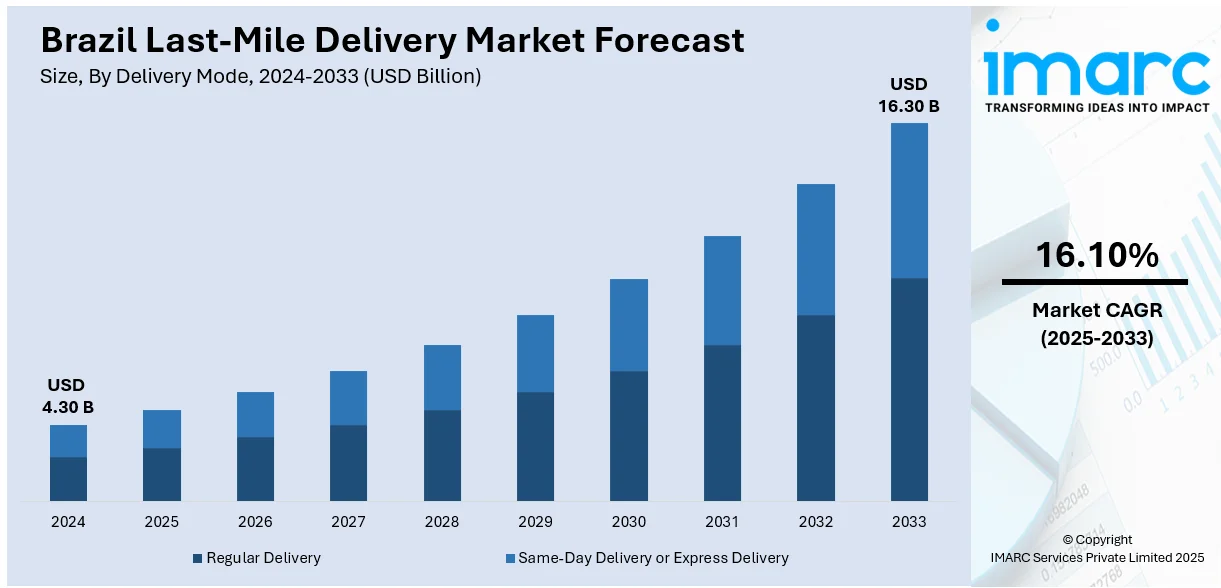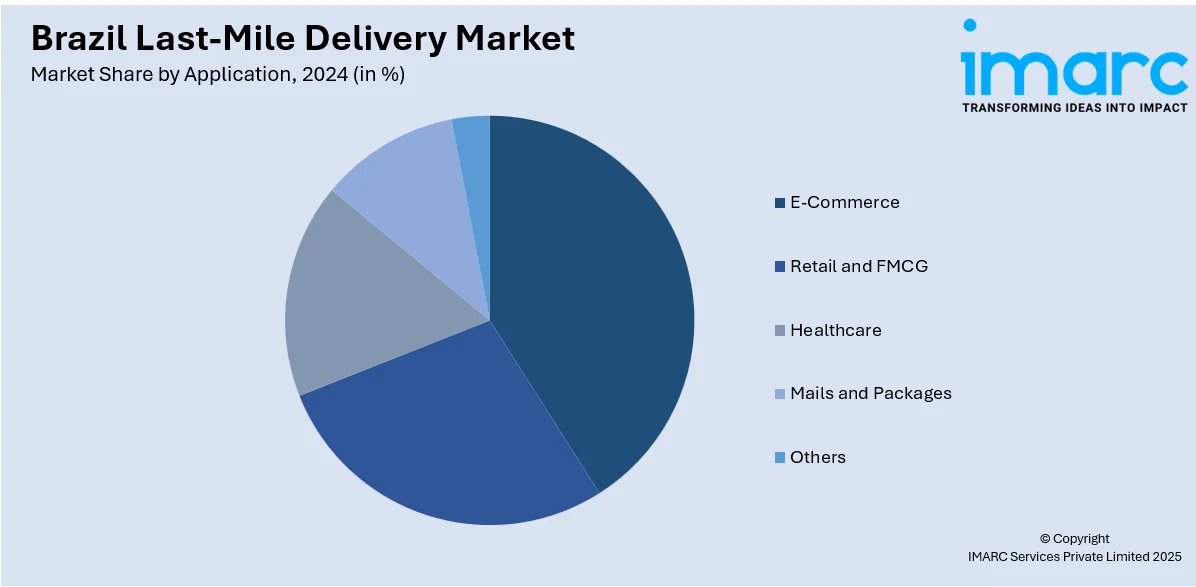
Brazil Last-Mile Delivery Market Size, Share, Trends, and Forecast by Delivery Mode, Application, Destination, Service Type, Vehicle Type, Mode of Operation, and Region, 2025-2033
Brazil Last-Mile Delivery Market Overview:
The Brazil last-mile delivery market size reached USD 4.30 Billion in 2024. Looking forward, IMARC Group expects the market to reach USD 16.30 Billion by 2033, exhibiting a growth rate (CAGR) of 16.10% during 2025-2033. The rapid growth of e-commerce, elevating customer need for rapid and convenient delivery options, innovations in technology, like route optimization and tracking systems, rapid urbanization, growing middle-class population, rising partnerships with local delivery services, and increasing investment in infrastructure are some of the major factors propelling the market growth in Brazil.
|
Report Attribute
|
Key Statistics
|
|---|---|
|
Base Year
|
2024 |
|
Forecast Years
|
2025-2033
|
|
Historical Years
|
2019-2024
|
| Market Size in 2024 | USD 4.30 Billion |
| Market Forecast in 2033 | USD 16.30 Billion |
| Market Growth Rate 2025-2033 | 16.10% |
Brazil Last-Mile Delivery Market Trends:
Growing E-commerce Sector
The increasing expansion of e-commerce in Brazil has significantly increased the demand for last-mile delivery services. According to the data from the International Trade Association, Brazil has emerged as Latin America’s largest economy and continues to witness bolstered e-commerce growth of 14.3%. As per the Brazilian Electronic Commerce Association, Brazil’s retail e-commerce increased to USD 34.5 billion in 2023 from USD 12.25 Billion in 2018, whereas the average order boosted in the same period to 470 from 435 reais. As more customers shop online, the need for effective and timely deliveries has become crucial, prompting logistics companies to enhance their last-mile capabilities. This, in turn, is expected to create a positive outlook for the market across the country. In addition, enhanced digital payment systems, robust internet penetration, and proliferating mobile commerce further aid the market’s steady growth. With more enterprises opting for omnichannel retail tactics, requirement for effective logistics services is anticipated to fuel further.

Rapid Urbanization and Changing Consumer Expectations
As urbanization accelerates, consumers expect faster and more convenient delivery options. This shift in consumer behavior drives companies to adopt innovative delivery solutions, such as same-day or next-day delivery services, to meet these heightened expectations and remain competitive in the market. For instance, in June 2023, DHL Supply Chain, a global logistics company, announced the launch of a new service in Brazil aimed at supporting the growth of logistics for online retailers, marketplaces, and industries. The service is called DHL Fulfillment Network (DFN), and it is a multiclient warehouse located in Barueri (SP) that provides access to DHL Supply Chain's e-commerce infrastructure in Brazil, consisting of 13 fulfillment centers, 6.5 thousand employees, 55 transportation hubs, and 800 vehicles. According to the company, the DFN structure can provide next-day nationwide delivery, as well as offer agility and operational flexibility to all clients. This innovation is part of an investment of R$ 800 million (around 159 million dollars) announced by the company in Brazil until 2025. As urban centers become more congested, logistics providers are also focusing on micro-fulfillment centers and alternative delivery models to optimize efficiency. Furthermore, increasing consumer preference for sustainable and green delivery solutions is prompting investments in electric vehicles and eco-friendly logistics infrastructure.
Brazil Last-Mile Delivery Market Segmentation:
IMARC Group provides an analysis of the key trends in each segment of the market, along with forecasts at the country level for 2025-2033. Our report has categorized the market based on delivery mode, application, destination, service type, vehicle type, and mode of operation.
Delivery Mode Insights:
- Regular Delivery
- Same-Day Delivery or Express Delivery
The report has provided a detailed breakup and analysis of the market based on the delivery mode. This includes regular delivery and same-day or express delivery.
Application Insights:

- E-Commerce
- Retail and FMCG
- Healthcare
- Mails and Packages
- Others
A detailed breakup and analysis of the market based on the application have also been provided in the report. This includes e-commerce, retail and FMCG, healthcare, mails and packages, and others.
Destination Insights:
- Domestic
- International
A detailed breakup and analysis of the market based on the destination have also been provided in the report. This includes domestic and international.
Service Type Insights:
- Business-To-Business (B2B)
- Business-To-Consumer (B2C)
- Customer-To-Customer (C2C)
A detailed breakup and analysis of the market based on the service type have also been provided in the report. This includes business-to-business (B2B), business-to-consumer (B2C), and customer-to-customer (C2C).
Vehicle Type Insights:
- Motorcycle
- LCV
- HCV
- Drones
A detailed breakup and analysis of the market based on the vehicle type have also been provided in the report. This includes motorcycle, LCV, HCV, and drones.
Mode of Operation Insights:
- Non-Autonomous
- Autonomous
A detailed breakup and analysis of the market based on the mode of operation have also been provided in the report. This includes non-autonomous and autonomous.
Regional Insights:
- Southeast
- South
- Northeast
- North
- Central-West
The report has also provided a comprehensive analysis of all the major regional markets, which include Southeast, South, Northeast, North, and Central-West.
Competitive Landscape:
The market research report has also provided a comprehensive analysis of the competitive landscape. Competitive analysis such as market structure, key player positioning, top winning strategies, competitive dashboard, and company evaluation quadrant has been covered in the report. Also, detailed profiles of all major companies have been provided.
Brazil Last-Mile Delivery Market News:
- In September 2024, Shopee announced the opening of six new logistics hubs in cities in Minas Gerais and Bahia states. With the new sites, the company announced it had expanded its operations to more than 100 logistics units in the country. The hubs serve as last-mile delivery points to the end-consumer.
Brazil Last-Mile Delivery Market Report Coverage:
| Report Features | Details |
|---|---|
| Base Year of the Analysis | 2024 |
| Historical Period | 2019-2024 |
| Forecast Period | 2025-2033 |
| Units | Billion USD |
| Scope of the Report | Exploration of Historical Trends and Market Outlook, Industry Catalysts and Challenges, Segment-Wise Historical and Future Market Assessment:
|
| Delivery Modes Covered | Regular Delivery, Same-Day or Express Delivery |
| Applications Covered | E-Commerce, Retail and FMCG, Healthcare, Mails and Packages, Others |
| Destinations Covered | Domestic, International |
| Service Types Covered | Business-To-Business (B2B), Business-To-Consumer (B2C), Customer-To-Customer (C2C) |
| Vehicle Types Covered | Motorcycle, LCV, HCV, Drones |
| Mode of Operations Covered | Non-Autonomous, Autonomous |
| Regions Covered | Southeast, South, Northeast, North, Central-West |
| Customization Scope | 10% Free Customization |
| Post-Sale Analyst Support | 10-12 Weeks |
| Delivery Format | PDF and Excel through Email (We can also provide the editable version of the report in PPT/Word format on special request) |
Key Questions Answered in This Report:
- How has the Brazil last-mile delivery market performed so far and how will it perform in the coming years?
- What is the breakup of the Brazil last-mile delivery market on the basis of delivery mode?
- What is the breakup of the Brazil last-mile delivery market on the basis of application?
- What is the breakup of the Brazil last-mile delivery market on the basis of destination?
- What is the breakup of the Brazil last-mile delivery market on the basis of service type?
- What is the breakup of the Brazil last-mile delivery market on the basis of vehicle type?
- What is the breakup of the Brazil last-mile delivery market on the basis of mode of operation?
- What is the breakup of the Brazil last-mile delivery market on the basis of region?
- What are the various stages in the value chain of the Brazil last-mile delivery market?
- What are the key driving factors and challenges in the Brazil last-mile delivery market?
- What is the structure of the Brazil last-mile delivery market and who are the key players?
- What is the degree of competition in the Brazil last-mile delivery market?
Key Benefits for Stakeholders:
- IMARC’s industry report offers a comprehensive quantitative analysis of various market segments, historical and current market trends, market forecasts, and dynamics of the Brazil last-mile delivery market from 2019-2033.
- The research report provides the latest information on the market drivers, challenges, and opportunities in the Brazil last-mile delivery market.
- Porter's five forces analysis assist stakeholders in assessing the impact of new entrants, competitive rivalry, supplier power, buyer power, and the threat of substitution. It helps stakeholders to analyze the level of competition within the Brazil last-mile delivery industry and its attractiveness.
- Competitive landscape allows stakeholders to understand their competitive environment and provides an insight into the current positions of key players in the market.
Need more help?
- Speak to our experienced analysts for insights on the current market scenarios.
- Include additional segments and countries to customize the report as per your requirement.
- Gain an unparalleled competitive advantage in your domain by understanding how to utilize the report and positively impacting your operations and revenue.
- For further assistance, please connect with our analysts.
 Inquire Before Buying
Inquire Before Buying
 Speak to an Analyst
Speak to an Analyst
 Request Brochure
Request Brochure
 Request Customization
Request Customization




.webp)




.webp)












